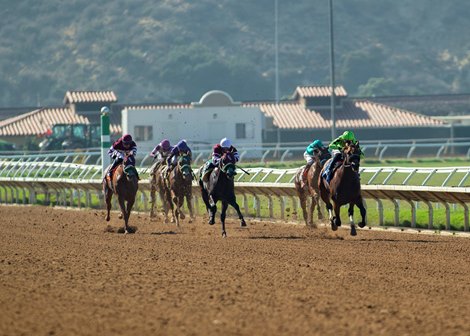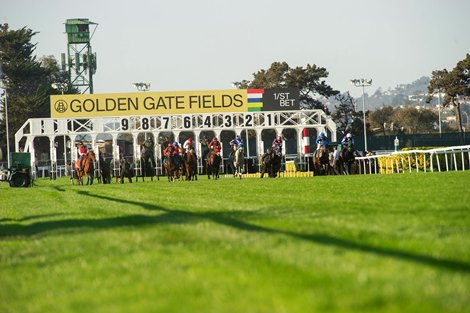A battle over Northern California race dates and a proposal to redirect funds to bolster Southern California purses yielded no action from the California Horse Racing Board during its monthly meeting Jan. 18.
The meeting took place in Sacramento, where Cal Expo stages harness racing and where the California Association of Racing Fairs would like to also add Thoroughbred racing next fall due to the impending closure of Golden Gate Fields. The CHRB meeting drew track and organization executives supportive of a consolidation of racing into the south and a CARF executive and Northern California horsemen critical of that move.
Larry Swartzlander, CARF’s executive director, outlined his organization’s vision for Northern California racing, with Cal Expo deemed as the best choice as the track best able to sustain racing in the region after the completion of the summer fairs. But to do so would require reaching an agreement with the harness industry, which currently holds a lease for racing through 2030.
Under Swartzlander’s proposal, a seven-furlong track would be built inside the existing one-mile dirt track. Standardbred horses racing there would utilize this inner dirt course, while the Thoroughbreds could race over the existing mile oval. Stabling would be expanded to accommodate additional horses coming into the facility.
Harness racing in California would likely continue at night, with Thoroughbred racing during the day.
Sign up for BloodHorse Daily
He said Pleasanton could serve as a back-up for Northern California racing if an agreement could not be reached for racing at Cal Expo or if the completion of the project could not occur by the fall. Pleasanton hosts a summer fair meet.
Swartzlander could provide few cost specifics or a timeline for the work to be completed, though he informed commissioners of individuals working on plans. He told the CHRB that he would meet with the Cal Expo board Jan. 26.
Two officials from Watch and Wager, which presents harness racing at Cal Expo, spoke later during the Thursday meeting. While they seemed open to working with CARF, “We’re not going down a path where we’re gonna go guarantee our own extinction,” said Christopher Schick, general manager at Watch and Wager.
CHRB executive director Scott Chaney pressed Swartzlander for specifics of building plans. He expressed surprise and suggested a floated $1.5 million estimate of track cost by Swartzlander as conservative. He added he “was concerned about the timeline and cost at Cal Expo.”
Elsewhere in the state, a synthetic training track at Santa Anita Park is currently being installed and is estimated to cost $7 million.
Additional challenges for Northern California would involve a track with expanded racing to become clean-water compliant, officials said.
Del Mar president Josh Rubinstein and Craig Fravel, executive vice chairman of 1/ST Racing, which operates Santa Anita Park and Golden Gate Fields in the state, suggested those costs are considerable, citing work done at their tracks in Southern California.
Rubinstein said a clean-water compliant project at Del Mar cost $12.5 million in 2014.

Racing at Del Mar
Rubinstein and Fravel, along with the Thoroughbred Owners of California and Los Alamitos Race Course, are among those who desire not to fill Northern California dates next fall and to instead replenish overpaid purse accounts in the south with redirected revenue from simulcasting. Without these redirected funds, Southern California tracks such as Santa Anita Park and Del Mar would be forced to cut purses. Santa Anita Park entered 2024 with a $3 million purse overpayment, and Del Mar overpaid purses by $2.1 million for their combined summer and fall meets.
Without gaming to aid their businesses, California tracks rely strictly on pari-mutuel wagering to fund purses.
TOC president and CEO Bill Nader, who led a presentation to commissioners outlining this proposed shift to Southern California, informed commissioners of the alarming continuation of declining foal crops and field size in the state.
“The overall health of California racing we know is not good,” he said.
The board appeared split regarding the best path forward for California. Commissioner Wendy Mitchell echoed some of Chaney’s feelings and stated her desire to avoid “false expectations.” Commissioners Damascus Castellanos and Oscar Gonzales expressed support for racing participants in the north. They voiced displeasure at the handling of 1/ST Racing’s planned closure of Golden Gate in June and a sudden 25% purse cut to offset longstanding purse overpayments.
If 1/ST Racing “would have come to us with proper notice, such as (now-closed) Hollywood Park and others have done, the groups that are in this room today could have gotten together and probably been done with this plan,” Castellanos said to applause from some in attendance.
Numerous Northern California horsemen spoke during the public comment portion of the meeting, including some former members of the TOC board, who resigned in opposition to the stance the organization chose to take in advance of Thursday’s meeting. Some critics of the TOC believe the organization favors interests in Southern California.
A collection of Northern California jockeys, trainers, owners, and breeders expressed how they believe redirecting funds to the south would turn California into a one-circuit state after about three months of Northern California fair racing next summer. Some urged patience from the board in advance of its next meeting in March and asked the CHRB to assist plan-making in the interim. Some proposed a state-run racetrack model similar to the New York Racing Association or what is being pitched in Maryland.
“I’m telling you, if we don’t have the dates assigned to the north and therefore the money goes to the south, that would be not only the end of Northern California racing, but even the fairs,” said Johnny Taboada, one of the former TOC board members. “So you talk about losing jobs; wait until you lose all the jobs from the fairs.”
Chair Dr. Greg Ferraro thanked all attendees for their input before adding, “I’m telling you, it’s not easy sitting in this chair looking at this situation. There’s almost a no-win situation for this board. We’re gonna do the best we can to do right by everybody. But obviously, we have no decision-making today. So we will have to end this meeting without a decision, and we’ll see what happens over the next couple of months. We’ll try and give everybody a chance to complete their information so we can make the right decision for all of you.”









Leave feedback about this